Excerpt from new book The No-Till Organic Vegetable Farm, available from Growing for Market here
By Daniel Mays
All the evidence shows we cannot improve on nature’s model. So how do we put into action ecological principles of soil care that are based on non-disturbance? This chapter, excerpted from my book The No-Till Organic Vegetable Farm, describes some of the techniques we employ to enhance the natural phenomena that protect and regenerate the soil.
Principles of soil care
As discussed in chapter two, the health of terrestrial ecosystems can be achieved by following the four basic principles of maximizing photosynthesis, biodiversity, and soil coverage while minimizing disturbance. These overlapping ideals guide our soil husbandry efforts at Frith Farm. Some of the practices discussed here have been employed since I started the farm nine years ago, and others are relatively new additions to our system.
There are no prescriptions for how best to nurture the soil, as true care comes from a personal relationship to the land and keen observation of the particular model nature has tailored for it. In any case, by following these natural principles I believe we are at least moving in the right direction.

After overwintering, cover crops are mown down by hand (or by foot), around June 1. All photos by John Benford.
Cover cropping
Living plants are the most natural way to nourish soil biology and generate soil health. Unlike soil amendments and imported organic matter, plants are living solar collectors customized to the conditions and needs of the soil. They pump the sun’s energy and the air’s carbon deep underground, feeding soil life in exchange for nutrients in a self-enriching cycle of symbiosis — all with minimal human intervention. This model of self-generating fertility is the renewable source of terrestrial wealth, and we all become poorer when we fail to maximize photosynthesis on the farm.
My definition of a cover crop is both broad and literal: a crop grown to cover and feed the soil. In this context, the distinction between a cash crop and a cover crop (or green manure) is irrelevant, as any crop can be grown for either or both of these purposes. Keeping a garden bed covered in a variety of living plants is more important than worrying about which plant is or is not classified as a “cover crop.” That said, there are particular plants that are especially effective at covering the soil, catching nutrients, and fixing carbon and nitrogen from the atmosphere. These species, many of which are grasses and legumes, are useful biological tools to help build soil and are what farmers generally refer to when talking about cover crops.
Integrating cover crops into a no-till system can be daunting. Most vegetables do not perform well when planted in a densely populated neighborhood of established plants. Without the plow, disc, and harrow to incorporate bulky residues, how are we to kill established cover and prepare beds for the following crop? Unsurprisingly, nature provides the answers to these questions. In undisturbed natural settings, plants routinely die in one of three ways:
They fulfill their life cycle.
They winterkill.
They are starved of light or other resources.
By embracing these natural methods, no-till cover crop management not only becomes possible, it also ends up being less work than any soil-disturbing alternative. With the right planning, we can wait for cover crops to fulfill their life cycle, stepping in at the end to mow, crimp, or knock them down prior to seed set; we can wait for the temperatures of winter to kill cold-sensitive species; or we can smother plants with tarps or with larger, faster-growing plants that outcompete them. We can use any combination of these techniques to transition beds from thick stands of maximized photosynthesis to an environment hospitable to new plants.
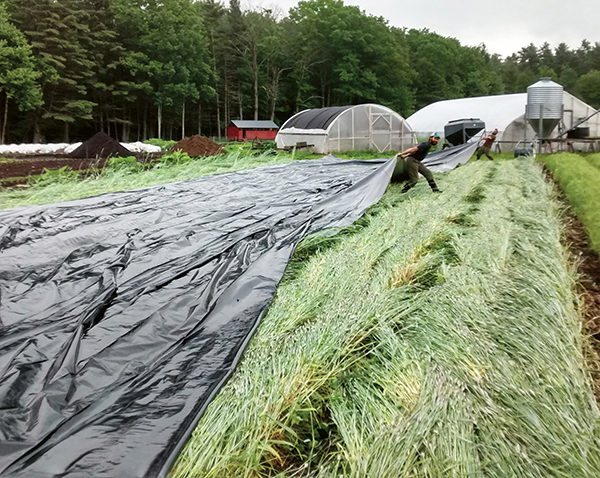
Then the crimped cover crop is tarped for two weeks to ensure it dies.
Note that time is a crucial element for all these techniques, and there is a waiting period involved with each. This is another way no-till practices differ from conventional methods: efficient no-till cover cropping requires greater patience and planning than tillage-based systems, as natural cycles generally progress slower than tractors.
Planning how a cover crop will be terminated and the bed transitioned to a new crop is important when tillage is off the table. In beds that will be planted early the following spring, we plant cover crop species that winterkill, allowing us to rake their remains into the paths and expose the beds for direct-seeding come April. For beds that will be planted the following summer, we seed cold-hardy annuals in the fall that survive the winter and grow vigorously in the spring, flowering in time for us to mow or knock them down, tarp, and then transplant the summer crop through the stubble (see Winter Cover Crops below).
When mowing or rolling (knocking down) a cover crop, timing is important in determining how quickly the crop will die. Grasses co-evolved with grazing animals and are well adapted to grow back repeatedly if mowed when young. Mowing or rolling is most effective at terminating a cover crop when it is timed with the peak of its flowering stage. This is important, as knocking down too early will result in regrowth that extends the tarping period required or competes with the subsequent crop, while knocking down too late results in unwanted seed production. Just because it was once a desired cover crop doesn’t mean it won’t become a weed. Tarping afterwards ensures the cover crop is thoroughly killed.
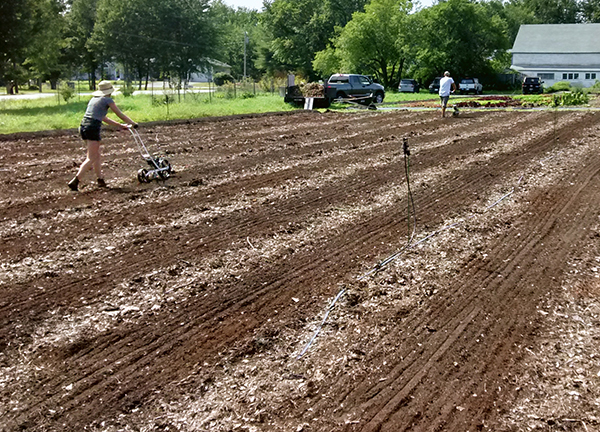
For fall cover crops, beds are direct-seeded in September with an Earthway seeder to ensure a better stand than broadcasting cover crop seeds.
With a plan for the termination of the cover crops, we can proceed with confidence and integrate the crops into our production rotation. There are many goals we might have when deciding to cover-crop, and any decent cover will meet many of  these at once:
Feed and sustain soil life
Break up compaction
Suppress weeds
Suppress pests or disease
Fix nitrogen
Fix carbon (generate biomass)
Catch nutrients and prevent leaching
Scavenge minerals
Feed beneficial insects
Produce forage
Produce a marketable harvest
Create an in situ mulch
Other considerations
Cover crop height (especially if undersowing)
Winterkill temperature, or cold-hardiness
Life cycle and flowering time
Ease of termination
Compatibility with other crops in mix.
Plantability of the bed after termination (ready for direct seeding, or only for transplants)
With these goals and management concerns in mind, we can start to make sense of the numerous species of cover crops available. Remember, these seeds are sparks that ignite the fire of natural fertility and soil health!
For the sake of simplicity, I group cover crops into four seasonal categories: winter, spring, summer, and fall. Their ideal uses and management are highly dependent on climate, so these categories should be adjusted to match your particular goals and setting.
Before you fixate on one or another cover crop to plant, keep in mind that there is tremendous value in expanding the diversity of cover crop mixes beyond the usual one or two ingredients. Rarely in nature do we see a field covered in just a couple of plant species; the natural soil care principle of maximizing diversity inspires us to do better. At Frith, we aim for at least three species in each mix, but some mixes may contain six or more. The way I see it, even if some varieties get outcompeted, all that’s lost is a small amount of seed. Spreading a diverse mix of seed is like casting a wide net — the odds of maximizing photosynthesis and the infiltration of roots throughout the soil profile are increased with every new species. Playing with different ratios and seeding rates is an ongoing process, but I try to err on the side of more seed rather than less.
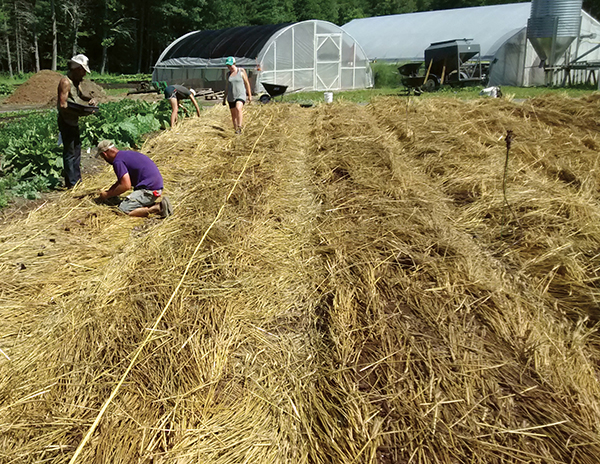
After crimping and tarping an overwintered cover crop, a cash crop can be transplanted through the in-situ mulch.
Seeding cover crop
To plant our cover crop seed, we use an Earthway push seeder after preparing the bed as we would for any other direct-seeded crop. While this requires a lot more walking back and forth than a broadcast seeder, it ensures proper spacing and good germination. For grass seed (oats, barley, rye, etc.), we use the Earthway’s beet plate; for peas, the small pea plate; and for small clover seed, the “lettuce, carrots, and other fine seed” plate. For most crop combinations we seed twelve rows total per bed, and we irrigate and weed the emerging cover crop as we would a cash crop.
Winter cover crops
Seeded by mid-fall, these crops survive winter and can be knocked down and killed in time for next season’s summer-transplanted crops. The extensive residues form an in situ mulch through which the summer crop is planted.
Basic mix: Winter rye and crimson clover
The rye builds biomass, catches nutrients, and insulates the crimson clover to survive winter, and both species flower early the next season (end of May for us in zone 4b). Adding winter wheat, hairy vetch, Austrian winter peas, and red clover multiplies the diversity benefits and ensures superlative photosynthesis.
Spring cover crops
Planted as soon as the ground thaws, these crops establish quickly in cool weather and flower in late spring or early summer, when they can be easily killed and raked aside for direct seeding.

Yields are strong with no machines or exposed soil. They pull only a handful of weeds from this 6,000-square-foot plot.
Basic mix: peas and oats
Oats build biomass and act as a nurse crop for the nitrogen-fixing peas, supporting them as they grow. We also harvest and sell the pea tendrils. Both species flower at the same time (early June for us) and are easily knocked down, smothered, and raked into the paths to expose the beds for direct seeding. Since the crop will be killed early in the summer, allowing weeds to grow in this mix can add valuable diversity! Nature does not recognize the concept of a “weed” and benefits from all plant diversity. Just make sure to mow or tarp before viable seeds are set.
Summer cover crops
Planted once the soil warms in late spring, these crops grow vigorously in warm weather, outcompeting weeds and generating large amounts of biomass before dying back with frost.
Basic mix: sorghum-Sudan grass and sunn hemp
These heat-loving powerhouses produce incredible amounts of biomass and can grow to over eight feet tall. They will increase root depth and total production if they are cut or grazed periodically, and they die with the first hard frost, allowing for easy planting the following spring. To spice things up, try adding other heat-loving crops, like cowpeas, millet, buckwheat, and subterranean clover to the mix, but be ready to graze or mow before any of these set seed. Cover crops like buckwheat or millet can readily reseed themselves, and potentially become a weed for subsequent crops.
A diverse summer cover-crop cocktail pumps carbon into the soil and hosts a  party for all manner of organisms.
Fall cover crops
Planted in early fall, these crops establish quickly in cool weather and die back in the cold of winter, allowing for early spring planting and direct seeding.
Basic mix: peas, oats, and forage radish
This mix is the same as our spring cover crop but with the addition of radishes. Sometimes called “tillage radish,” these daikon relatives open up deep channels with their vigorous taproots, breaking up compaction and improving drainage and tilth. All three crops establish well if planted by early September (here in zone 4b), and they winterkill when lows hit about 10°F (–12°C). With the cold of winter as a reliable way to kill them, we can add any array of cold-sensitive crops to the mix, including tender barley varieties, fava beans, berseem clover, subterranean clover, or any other plants that don’t survive a winter in our climate.
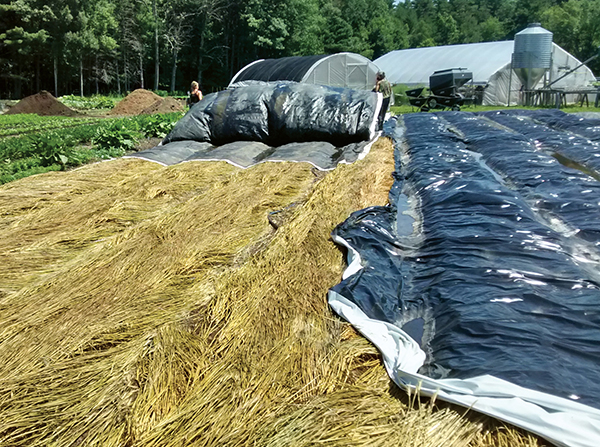
Seasonal observations
I try to arrange the crop plan such that any beds that will be cover-cropped in the spring can be planted the preceding fall so that there is living growth through winter. Though largely dormant, these plants hold their relationships with soil organisms through the cold months and hit the ground running as soon as the thaw begins. Spring-planted crops, on the other hand, require the bed to be plantable, and thus relatively free of living growth as winter ends. If we are going to devote valuable spring bed space to cover crops, we may as well get the added benefit of living winter cover beforehand as well as eliminate the bed prep and planting required during the busy months of spring. The only exception is when a summer crop needs to be direct seeded, which is far easier after a spring crop of peas and oats than after an overwintered cover crop like winter rye.
An allelopathic effect follows the termination of certain crops, reducing seed germination for a period of up to several weeks. This effect can either be a blessing or a curse, depending on what’s next in your crop plan. The allelopathy of winter rye is well-known, and transplanting through a thick in situ mulch of overwintered rye can lead to near-weedless beds for the rest of the season. Attempting to direct seed a crop immediately after winter rye, on the other hand, can give poor results.
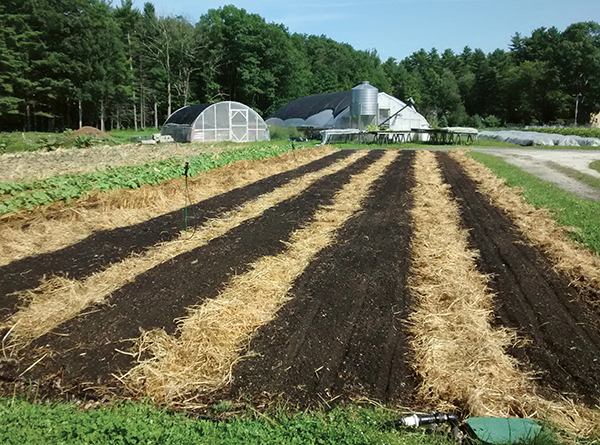
The benefits of overwintered cover crops like rye are often worth the additional crop plan constraints. Maintaining living roots through the winter holds soil structure and supports a vast array of soil organisms. Of special note are the mycorrhizal relationships that are preserved into the next season, as described in chapter 2. Without this fungal bridge, the roots of the next year’s crop start out naked and lonely while the mycorrhizal network recovers from a period of famine.
For climates with mild winters, cash crops can provide year-round photosynthesis and living fungal connections. In colder climates, however, not many vegetable species survive the winter. Notable exceptions are garlic and hardy biennial crops, like parsnips, carrots, beets, chard, and onions. Though typically grown as annuals, these crops can assist in the preservation of soil life when overwintered for seed production. Even for avid seed savers, however, it is unlikely that vegetable species will fully cover the soil with living growth through northern winters. Cover crop species, especially varied mixes of grasses and legumes, enable a level of photosynthesis, diversity, and soil coverage that is not possible with vegetables alone.
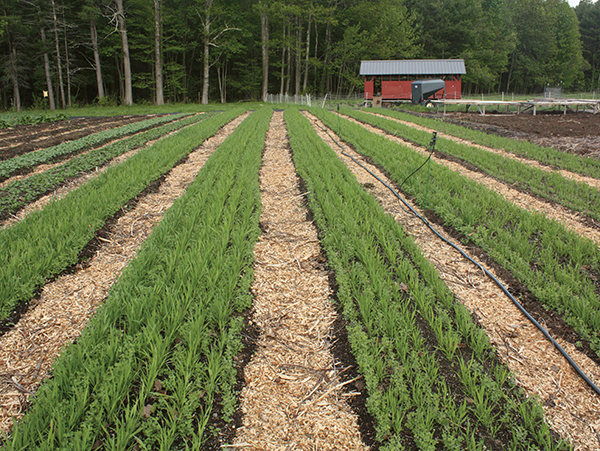
Multicropping
A simple way to increase photosynthesis, diversity, and soil coverage all at once is to grow more than one type of crop in one place. This stacking of functions to increase net productivity can take various names and forms: interplanting, undersowing, companion planting, interseeding, or multicropping. In a broader sense, alley cropping, silvopasture, livestock integration, and perennial polycultures are all forms of multicropping as well, though they are less commonly associated with vegetable production. One of the multicropping combinations with the longest track record is the “Three Sisters” mix of corn, squash, and beans — a version of the milpa agricultural system developed by indigenous peoples of the Americas, mentioned in chapter two.
Many commercial farmers dismiss the idea of multicropping because it complicates field management, especially if mechanization is involved. Concerns around plant spacing, harvest windows, and crop rotation are multiplied when there is more than one crop per bed. While some may find this daunting, I see it as an opportunity to increase soil health with nothing but some extra planning! The no-till farmer is used to replacing mechanical simplicity with biological complexity, so why not carry this forward with multicropping?
Daniel Mays runs Frith Farm in Scarborough, Maine. This article is excerpted from his new book, The No-Till Organic Vegetable Farm © by Daniel Mays, photography © by John Benford, used with permission from Storey Publishing. The book is available from Growing for Market here.
